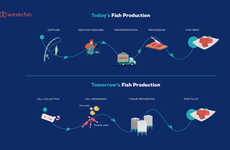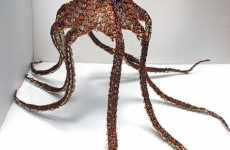
Conjoined Nile Tilapia
Have you ever seen conjoined twin fish? These conjoined Nile tilapia fish swim in a Bangkok aquarium. They are eight months old and share a part of their stomachs. The bigger fish tends to protect the smaller one from harm, while the smaller one looks for food at the bottom of the aquarium.
Nile tilapia can reach a maximum of two feet in length and can weigh up to nine pounds. Originally from waters stretching from Africa to the Cape Horn, the fish was introduced to freshwater irrigation systems so as to fight algae growth but has now become a pest.
Nile tilapia can reach a maximum of two feet in length and can weigh up to nine pounds. Originally from waters stretching from Africa to the Cape Horn, the fish was introduced to freshwater irrigation systems so as to fight algae growth but has now become a pest.
Trend Themes
1. Conjoined Fish - The unique phenomenon of conjoined fish presents opportunities for genetic research and medical advancements in understanding biological anomalies.
2. Aquarium Innovation - Innovative advancements in aquarium design and technology can capitalize on the public's fascination with rare and unusual aquatic specimens, creating immersive and educational experiences.
3. Aquatic Pest Control - The proliferation of Nile tilapia and other invasive fish species calls for disruptive approaches in pest control methods, such as the development of sustainable and eco-friendly solutions.
Industry Implications
1. Genetics and Biotechnology - The study of conjoined fish provides an opportunity for geneticists and biotech companies to explore the mechanisms behind genetic abnormalities and develop novel applications.
2. Aquarium and Aquatic Sciences - The conjoined fish phenomenon sparks innovative ideas in aquarium and aquatic sciences, driving advancements in breeding techniques, tank designs, and species preservation strategies.
3. Environmental Conservation - Efforts to control the spread of invasive fish species like Nile tilapia create room for disruptive approaches in sustainable pest management and ecological restoration methods.
4
Score
Popularity
Activity
Freshness























